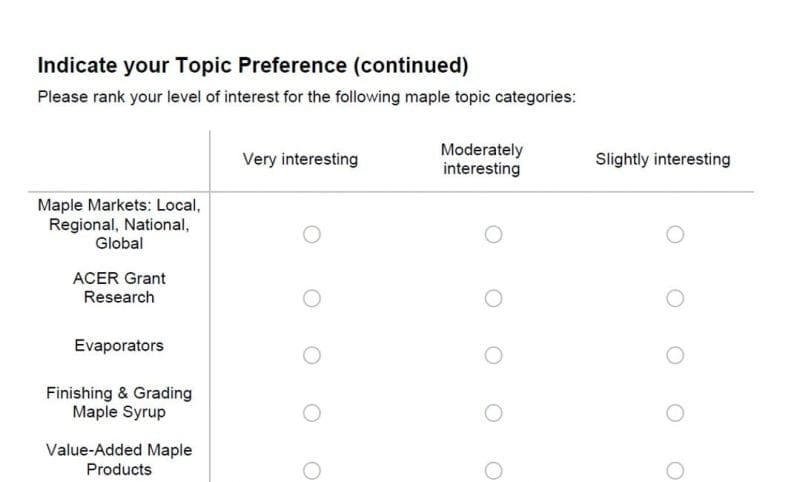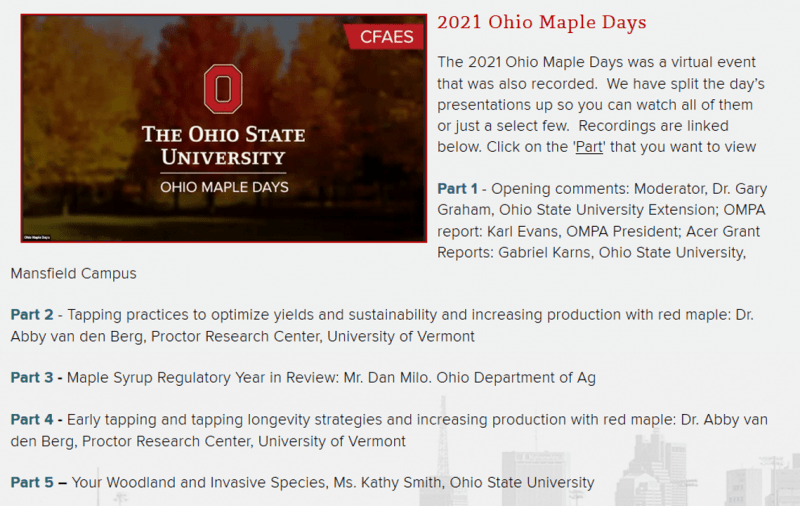Ohio Maple Days was a great success again this early December with a wonderful slate of speakers and solid growth over last year’s attendance. But before we get to Saturday’s main event, there was a lot of excitement that cannot be overlooked from that Friday.
On Friday afternoon, over 30 people participated in an exceptional value-added maple products workshop in Ashland University’s state-of-the-art teaching kitchen. Several maple producers – namely Galen Smith, Dan Brown, Jen Freeman, and Fred Ahrens – demonstrated how to make delicious (and yes there was PLENTY of taste testing!) maple candy, maple cream, maple sugar, and maple cotton candy. Contributions from numerous others behind the scenes must be acknowledged, and I even got to participate by contributing a maple venison breakfast sausage link exhibition at the end. All participants left full of good bites to eat and full of knowledge, tips and tricks to either get into the value-added products game or improve their already developed skill set. It is always so much fun to participate in a workshop where the speakers, as well as many of the attendees, are interacting back-and-forth with one another from beginning to end.
Friday evening’s main event was spearheaded by the Ohio Maple Producer’s Association – “One Sweet Gathering.” Raffles and trivia night carried the audience through lots of maple-themed questions and more participants than not left with one or multiple prizes. This event has become one of my favorite as it affords us an opportunity to interact with everyone in a low stakes environment – there is no agenda that has to be accomplished, no itinerary that is dependent on staying on time. Lots of great conversation, laughs, and of course excellent food and drinks carried the night, and OMPA was able to raise a substantial sum for the OSU maple research program – an extremely generous gesture to push for more and better work on their behalf! Thanks!!
For Saturday’s main event, Aaron Wilson – Buckeye Universe’s State Climatologist – keynoted with an excellent hour-long talk discussing the implications of El Nino’s resurgence on sugarmakers. Regulatory updates and labeling requirements from Ohio Dept. of Agriculture, the latest on spotted lanternfly, and a primer on tubing and vacuum systems from Mike Lynch of CDL rounded out the morning’s agenda.
The chefs at Ashland University continue to outdo themselves and offered up yet another showstopper of a lunch. As entrees and desserts were enjoyed, Roger & Suzie Gortner and Paul Snavely from the Snavely Sugar Shack were overwhelmed by congratulations on receiving the Charles Keiter Award.
Saturday afternoon offered a split agenda with a Beginner or Advanced track. Spot checking attendance in each, most talks were roughly half and half throughout the final sessions. One highlight for us was sharing the Sugarhouse Videos created at Gingerich Brothers & Sperry LLC, Seldom Seen Farms, and Double G Maple. Those short videos will be featured in the digital Maple Toolbox which is almost completed and will be available soon. Other Advanced talks focused on NRCS cost-share programs for enhanced sugarmaking sustainability, crop tree management in a sugarbush, and coupling gourmet mushroom cultivation with your maple woods. The Beginner track started in the obvious place – how to identify different maple species, and it then progressed through different sap collection methods, a crash course on evaporators and reverse osmosis, before concluding with economic and enterprise planning.
Last but certainly not least, I have to give a shout out to Galen Smith for leading a team of folks to host the John Berry Memorial Syrup Contest. Bruce Kavanagh took first in the Delicate class, Goodell Family Farms for Amber, and Aggie from Gingerich Brothers & Sperry led the Robust class. The Dick Schoor Award for best syrup from a new or small producer was awarded to Bruce Kavanagh, and the Hilton Farly Award was won by Aggie Sperry.
We hope you can join us next year (actually this year…Happy New Year!) on December 6 for the 2024 edition of Ohio Maple Days! SAVE THE DATE!!





























